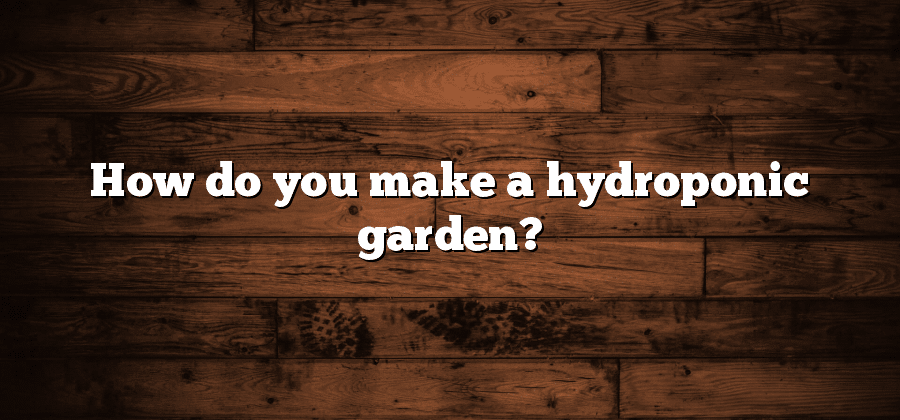Understanding Hydroponics: The Basics
Hydroponics is a method of growing plants without the use of soil. Instead, plants are grown in a nutrient-rich water solution, allowing them to obtain the essential nutrients they need for growth. This technique has gained popularity in recent years due to its numerous advantages over traditional soil-based gardening.
One of the main benefits of hydroponics is the ability to control the growing environment. By providing the right temperature, lighting, and nutrient levels, plants can thrive in a hydroponic system. This not only results in faster growth and higher yields but also allows for year-round cultivation, regardless of the climate or season. Additionally, the absence of soil reduces the risk of pests, diseases, and weeds, making hydroponics an attractive option for both commercial growers and home gardeners.
Essential Components for a Hydroponic Garden
Hydroponics is a method of growing plants without soil, using a nutrient-rich water solution instead. To successfully set up a hydroponic garden, there are several essential components that you need to consider. Firstly, a quality grow light is crucial for providing the necessary spectrums of light for the plants’ growth. LED lights are commonly used in hydroponic systems due to their energy efficiency and ability to produce the specific wavelengths needed for photosynthesis.
Another important component is a reservoir or tank to hold the nutrient solution. This is where the water-based mixture of essential minerals and nutrients is stored and circulated to nourish the plants’ roots. It is essential to choose a reservoir that is suitable for the size of your hydroponic garden and can effectively maintain the desired nutrient levels. Additionally, a reliable pump is required to circulate the nutrient solution throughout the system, providing a continuous supply of nutrients to the plants’ root systems.
Together, these components form the foundation of a successful hydroponic garden. As you delve deeper into the world of hydroponics, you will discover an array of additional components and accessories that can enhance your system’s efficiency and productivity. However, by prioritizing a quality grow light, a suitable reservoir, and an efficient pump, you will be well on your way to creating a thriving hydroponic garden.
Selecting the Right Hydroponic System
When it comes to selecting the right hydroponic system for your garden, there are a few factors to consider. First and foremost, you need to think about the space you have available. Are you looking to set up a small indoor garden or do you have a larger outdoor area to work with? The size of your space will determine the type and scale of the hydroponic system you should choose.
Another important factor to consider is your level of experience and skill in hydroponics. Some systems are more complex and require more technical knowledge to set up and maintain, while others are more beginner-friendly. It’s crucial to assess your own capabilities and choose a system that aligns with your skill level.
Additionally, you should take into account the type of plants you plan on growing. Certain systems are better suited for certain types of crops. For example, deep water culture systems are ideal for leafy greens, while nutrient film technique systems are better suited for vine crops like tomatoes or cucumbers. Researching and understanding the specific needs of your desired plants will help you make an informed decision.
Ultimately, selecting the right hydroponic system involves careful consideration of factors such as available space, personal skill level, and the specific needs of your plants. Taking the time to evaluate these aspects will ensure that you choose a system that is not only suitable for your circumstances but also enhances the growth and productivity of your hydroponic garden.
Choosing the Ideal Growing Medium
When it comes to hydroponic gardening, selecting the ideal growing medium is crucial for the successful growth and development of your plants. Unlike traditional soil-based gardening, hydroponics relies on a soilless medium to provide plants with the necessary support, oxygen, and nutrient transport. There are several options to choose from when it comes to hydroponic growing mediums, each with its own advantages and considerations.
One popular choice for hydroponic systems is coco coir, a natural fiber derived from the husks of coconuts. Coco coir has excellent water-retention properties while still allowing for good drainage, ensuring that the plants receive just the right amount of moisture. Additionally, coco coir is a sustainable and renewable resource, making it an eco-friendly option for hydroponic gardeners. However, it’s important to note that coco coir tends to be slightly acidic, so it may require some buffering to maintain a suitable pH level for your plants.
Nutrient Solutions: Providing Essential Plant Nutrition
Plants obtain essential nutrients from the soil in traditional gardening methods. However, in hydroponic gardening, nutrient solutions play a crucial role in supplying plants with the necessary nutrients for development. These solutions are carefully formulated to provide a balanced blend of essential elements, including nitrogen, phosphorus, and potassium.
The nutrient solutions used in hydroponic gardening are highly concentrated and are typically mixed with water before being delivered to the plants. The composition of the solution can vary depending on the specific needs of the plants being grown. It is essential to monitor and adjust the nutrient solution regularly to ensure that the plants receive the proper amount of nutrients for optimal growth. The success of any hydroponic garden relies heavily on the consistent and precise delivery of nutrient solutions to support plant nutrition.






